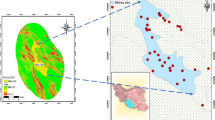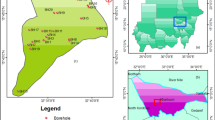Abstract
Monitoring and assessment of groundwater quality (GWQ) as an important freshwater source for drinking purposes in urban and rural regions of developing countries due to rapidly increasing contamination is one of the concerns of water managers. Therefore, developing an efficient intelligent model for analyzing GWQ could help hydro-environmental engineers for sustainable water supply. The current research investigated the applicability of a novel nature-inspired optimization algorithm hybridized with multi-layer perceptron artificial neural network based on gray wolf optimization (GWO) for estimating dissolved oxygen (DO) total dissolved solid (TDS) and turbidity parameters at Asadabad Plain, Iran, and results are compared with the stand-alone multi-layer perceptron artificial neural network (MLPANN), generalized regression neural network (GRNN), and multiple linear regression (MLR) approaches. Evaluation of performance of models is carried out using various statistical indices like relative root mean square error, Nash-Sutcliffe efficiency, and correlation coefficient. Based on the results obtained, it is found that the hybrid GWO-MLPANN is a beneficial GWQ forecasting tool in accordance to high performance accuracy. Also, the study found that the superiority of the applied meta-heuristic algorithm (GWO) in improving the performance accuracy of the stand-alone artificial intelligence techniques in modeling the GWQ parameters.










Similar content being viewed by others
Data availability
The authors declare that they have not need research data support with this submission. Also, the authors are sure that all data and materials as well as software application or custom code support their published claims and comply with field standards.
References
Aduojo AA, Adebowole AE, Okezie U (2020) Modeling groundwater total dissolved solid from derived electromagnetic data using multiple linear regression analysis: a case study of groundwater contamination. Model Earth Syst Environ 6(3):1863–1875
Ali M, Prasad R, Xiang Y, Deo RC (2020) Near real-time significant wave height forecasting with hybridized multiple linear regression algorithms. Renew Sust Energ Rev 132:110003
Alizamir M, Sobhanardakani S (2016) Forecasting of heavy metals concentration in groundwater resources of Asadabad plain using artificial neural network approach. J Adv Environ Health Res 4(2):68–77
Alizamir M, Sobhanardakani S (2017a) A comparison of performance of artificial neural networks for prediction of heavy metals concentration in groundwater resources of Toyserkan Plain. Avicenna J Environ Health Eng 4(1):11792–11792
Alizamir M, Sobhanardakani S (2017b) Predicting arsenic and heavy metals contamination in groundwater resources of Ghahavand plain based on an artificial neural network optimized by imperialist competitive algorithm. Environ Health Eng Manage J 4(4):225–231
Alizamir M, Sobhanardakani S, Taghavi L (2017) Modeling of groundwater resources heavy metals concentration using soft computing methods: application of different types of artificial neural networks. J Chem Health Risk 7(3):207–216
Alizamir M, Sobhanardakani S (2018) An artificial neural network-particle swarm optimization (ANN-PSO) approach to predict heavy metals contamination in groundwater resources. Jundishapur J Health Sci 10(2):e67544
Alizamir M, Sobhanardakani S, Hasanalipour Shahrabadi A (2019) Prediction of heavy metals concentration in the groundwater resources in Razan Plain: extreme learning machine vs. artificial neural network and multivariate adaptive regression spline. Ann Mil Health Sci Res 17(4):e98554
Alizamir M, Kim S, Kisi O, Zounemat-Kermani M (2020) A comparative study of several machine learning based non-linear regression methods in estimating solar radiation: case studies of the USA and Turkey regions. Energy 197:117239
Alizamir M, Heddam S, Kim S, Mehr AD (2021) On the implementation of a novel data-intelligence model based on extreme learning machine optimized by bat algorithm for estimating daily chlorophyll-a concentration: case studies of river and lake in USA. J Clean Prod 285:124868
Alley WM, Healy RW, LaBaugh JW, Reilly TE (2002) Flow and storage in groundwater systems. Science 296(5575):1985–1990
Allouche N, Maanan M, Gontara M, Rollo N, Jmal I, Bouri S (2017) A global risk approach to assessing groundwater vulnerability. Environ Model Softw 88:168–182
Bedi S, Samal A, Ray C, Snow D (2020) Comparative evaluation of machine learning models for groundwater quality assessment. Environ Monit Assess 192(12):1–23
Bui DT, Khosravi K, Karimi M, Busico G, Khozani ZS, Nguyen H, Kazakis N (2020) Enhancing nitrate and strontium concentration prediction in groundwater by using new data mining algorithm. Sci Total Environ 715:136836
El Bilali A, Taleb A, Brouziyne Y (2021) Groundwater quality forecasting using machine learning algorithms for irrigation purposes. Agr Water Manage 245:106625
Fazel Tavassol S, Gopalakrishna GS (2015) Qualitative classification of Asadabad Hamedan plain water resources for various application using hydrogeochemical analysis data. XIV Convention of Mineralogical Society of India and National seminar on recent advances in research on Precambrian terrains in India.
Mirjalili S, Mirjalili SM, Lewis A (2014) Grey wolf optimizer. Adv Eng Softw 69:46–61
Hakim AMY, Baja S, Rampisela DA, Arif S (2020) Modelling land use/land cover changes prediction using multi-layer perceptron neural network (MLPNN): a case study in Makassar City, Indonesia. Int J Environ Stud 78:301–318. https://doi.org/10.1080/00207233.2020.1804730
Haykin S (1998) Neural networks—a comprehensive foundation, 2nd edn. Prentice-Hall, Upper Saddle River, pp 26–32
Hong H, Tsangaratos P, Ilia I, Loupasakis C, Wang Y (2020) Introducing a novel multi-layer perceptron network based on stochastic gradient descent optimized by a meta-heuristic algorithm for landslide susceptibility mapping. Sci Total Environ 742:140549
Jafari R, Torabian A, Ghorbani MA, Mirbagheri SA, Hassani AH (2019) Prediction of groundwater quality parameter in the Tabriz plain, Iran using soft computing methods. J Water Suppl Res Technol—AQUA 68(7):573–584
Jang WS, Engel B, Yeum CM (2020) Integrated environmental modeling for efficient aquifer vulnerability assessment using machine learning. Environ Model Softw 124:104602
Jha MK, Shekhar A, Jenifer MA (2020) Assessing groundwater quality for drinking water supply using hybrid fuzzy-GIS-based water quality index. Water Res 179:115867
Kadam AK, Wagh VM, Muley AA, Umrikar BN, Sankhua RN (2019) Prediction of water quality index using artificial neural network and multiple linear regression modelling approach in Shivganga River basin, India. Model Earth Syst Environ 5:951–962
Kisi O, Alizamir M, Docheshmeh Gorgij A (2020) Dissolved oxygen prediction using a new ensemble method. Environ Sci Pollut Res 27:9589–9603
Kisi O, Azad A, Kashi H, Saeedian A, Hashemi SAA, Ghorbani S (2019) Modeling groundwater quality parameters using hybrid neuro-fuzzy methods. Water Res Manage 33(2):847–861
Lan T, Tong C, Yu H, Shi X, Luo L (2020) Nonlinear process monitoring based on decentralized generalized regression neural networks. Expert Syst Appl 150:113273
Maroufpoor S, Jalali M, Nikmehr S, Shiri N, Shiri J, Maroufpoor E (2020) Modeling groundwater quality by using hybrid intelligent and geostatistical methods. Environ Sci Pollut Res 27:28183–28197
Mukate S, Panaskar D, Wagh V, Muley A, Jangam C, Pawar R (2018) Impact of anthropogenic inputs on water quality in Chincholi industrial area of Solapur, Maharashtra, India. Groundw Sustain Dev 7:359–371
Pham QB, Mohammadpour R, Linh NTT, Mohajane M, Pourjasem A, Sammen SS, Anh DT (2021) Application of soft computing to predict water quality in wetland. Environ Sci Pollut Res 28(1):185–200
Rajaee T, Nourani V, Zounemat-Kermani M, Kisi O (2011) River suspended sediment load prediction: application of ANN and wavelet conjunction model. J Hydrol Eng 16(8):613–627
Shah MI, Javed MF, Abunama T (2021) Proposed formulation of surface water quality and modelling using gene expression, machine learning, and regression techniques. Environ Sci Pollut Res 28(11):13202–13220
Snedecor GW, Cochran WG (1981) Statistical methods, 7th edn. Iowa State Univ. Press, Ames
Specht DF (1991) A general regression neural network. IEEE T Neural Netw 2(6):568–576
Sobhanardakani S (2016) Evaluation of the water quality pollution indices for groundwater resources of Ghahavand plain, Hamadan province, western Iran. Iran J Toxicol 10(3):35–40
Sobhanardakani S, Yari AR, Taghavi L, Tayebi L (2016) Water quality pollution indices to assess the heavy metal contamination, case study: groundwater resources of Asadabad Plain in 2012. Arch Hyg Sci 5(4):221–228
Sobhanardakani S, Taghavi L, Shahmoradi B, Jahangard A (2017) Groundwater quality assessment using the water quality Pollution indices in Toyserkan Plain. Environ Health Eng Manage J 4(1):21–27
Solley WB, Pierce RR, Perlman HA (1998) Estimated use of water in the United States in 1995. US Geol Surv
Vijay S, Kamaraj K (2021) Prediction of water quality index in drinking water distribution system using activation functions based Ann. Water Resour Manag 35(2):535–553
Wong YJ, Arumugasamy SK, Chung CH, Selvarajoo A, Sethu V (2020) Comparative study of artificial neural network (ANN), adaptive neuro-fuzzy inference system (ANFIS) and multiple linear regression (MLR) for modeling of Cu (II) adsorption from aqueous solution using biochar derived from rambutan (Nephelium lappaceum) peel. Environ Monit Assess 192(7):439
Yari AR, Sobhanardakani S (2016) Water quality assessment of groundwater resources in Qaleeh Shahin Plain based on Cd and HEI. Int Arch Health Sci 3(3):101–106
Yuan Q, Xu H, Li T, Shen H, Zhang L (2020) Estimating surface soil moisture from satellite observations using a generalized regression neural network trained on sparse ground-based measurements in the continental US. J Hydrol 580:124351
Zhang H, Wang J, Sun Z, Zurada JM, Pal NR (2019) Feature selection for neural networks using group lasso regularization. IEEE Trans Knowl Data Eng 32(4):659–673
Acknowledgements
The authors are grateful to the Hamedan Branch, Islamic Azad University for providing facilities to conduct and complete this study.
Author information
Authors and Affiliations
Contributions
All authors contributed to the study conception and design. Material preparation, data collection, and analysis were performed by Azadeh Ghobadi, Mehrdad Cheraghi, Soheil Sobhan Ardakani, Bahareh Lorestani, and Hajar Merrikhpour. The first draft of the manuscript was written by Azadeh Ghobadi and Soheil Sobhan Ardakani, and all authors commented on previous versions of the manuscript. The corresponding author ensures that all listed authors have approved the manuscript before submission, including the names and order of authors.
Corresponding author
Ethics declarations
Ethics approval and consent to participate
This article does not contain any studies with animals and human subjects. The authors confirm that all the research meets ethical guidelines and adheres to the legal requirements of the study country.
Consent for publication
The authors declare that this manuscript does not contain any individual person’s data and material in any form.
Conflict of interest
The authors declare no competing interests.
Additional information
Responsible editor: Xianliang Yi
Publisher’s note
Springer Nature remains neutral with regard to jurisdictional claims in published maps and institutional affiliations.
Rights and permissions
About this article
Cite this article
Ghobadi, A., Cheraghi, M., Sobhanardakani, S. et al. Groundwater quality modeling using a novel hybrid data-intelligence model based on gray wolf optimization algorithm and multi-layer perceptron artificial neural network: a case study in Asadabad Plain, Hamedan, Iran. Environ Sci Pollut Res 29, 8716–8730 (2022). https://doi.org/10.1007/s11356-021-16300-4
Received:
Accepted:
Published:
Issue Date:
DOI: https://doi.org/10.1007/s11356-021-16300-4




